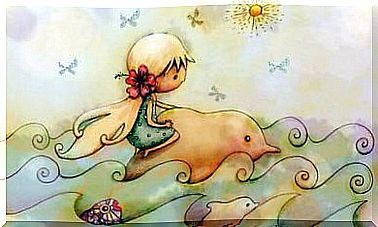What Is Egocentric Language?

We have all ever surprised someone speaking to themselves, even we ourselves can have dated it countless times. Now, if there are true specialists in this practice, it is children. Thus, for example, many children under 6 years old seem to have a self-centered and spontaneous language that helps them in their growth.
This egocentric language is a very attractive phenomenon for developmental psychology. Although language has a very strong social character, it seems to hide something else. Its spontaneous use and insensitivity to the presence of an interlocutor could be an indicator that it fulfills more functions in addition to social communication.
In this article we are going to explore two different theories that attempt to explain the appearance and functions of egocentric language. These theories come from the hand of two of the most relevant psychologists in the study of developmental psychology. These are Jean Piaget and Lev Vygotsky; which present us with two very different and interesting explanations of this phenomenon.
Piaget’s egocentric language theory
To understand Piaget’s egocentric language perspective, it is necessary to frame it in his theory of development, which is based on the development of logical intelligence.
Thus, the child’s ability to relate to others will be conditioned by this type of development. Specifically, according to Piaget, the child will show a deficit in their social interactions until they develop the so-called “theory of mind”.
Thus, studies such as the one carried out at the University of Nevada, United States, egocentric language would be part of that stage prior to socialized language. It is therefore a stage where the child’s mind has not yet assumed the perspective of the environment, of those who are part of their immediate context.
Characteristics of egocentric language according to Piaget
For Piaget, egocentric language would be a phenomenon centered on the sender himself, without attending to the perspective of the other. This would occur due to the fact that the child still lacks the capacity for social interaction. In addition, we also observe this type of egocentric behavior on other planes, such as thought and perception.
This linguistic behavior is expressed through three very specific phases according to Piaget:
- Repetition (echolalia) where the child repeats words for simple pleasure.
- Monologue: express your thoughts out loud.
- Dual or collective monologue: in this case the little one already interacts with other children.

Now, why does language appear without a communicative utility?
- Piaget says that egocentric language appears as an expression of the symbolic function that the child has just acquired.
- Around the age of 3, the child begins to acquire the ability to represent his world through language, but has not yet fully understood its social function.
- For this reason, we see a use of language based on oneself, since it would be fulfilling a symbolic and non-communicative function.
- Around 6-7 years, the child will acquire the theory of mind. Which will lead you to understand social interaction and the importance of language as an instrument of communication.
In most cases, these would be sufficient stimuli for the child to abandon egocentric thinking and egocentric language, giving way to logical thinking and developing the communicative aspects of language.
Vygotsky’s theory of egocentric language
Vygotsky offers us a totally different explanation for egocentric language. It postulates that sociocultural factors influence us from the earliest childhood.
Thus, he rejects Piaget’s premise that the child before 6 years of age is not interested in social interaction. The communicative attempts of babies would show us that interest in social life.
For Vygotsky, language is born with a social and communicative function. The child speaks to communicate with others and in turn develops the symbolic function in the social context.
Now, through the use of language, the child begins to discover another very important function of it. This is about the ability of language to self-regulate behavior: language helps us to structure our thoughts and actions.

Characteristics of egocentric language according to Vygotsky
Egocentric language, according to Vygotsky, would be nothing more than a use of language that seeks to improve self-regulation. For this reason, it would appear without the need for an interlocutor. But then why does self-centered language disappear at the age of 6?
It is here that a key process appears in Vygotsky’s theory, internalization.
- At 6 years of age, the child would already be able to internalize this egocentric language and make it part of their thinking.
- So the self-regulatory function would become part of our internal discourse. This theory explains the genesis of language as the central support of our thought.
To conclude, as we have seen through these two perspectives, language is a complex process with many nuances and dimensions. Something like this demands an exhaustive investigation in exchange for finding some answers to the questions it poses to us. All of this will also allow us to give better care to our children.









